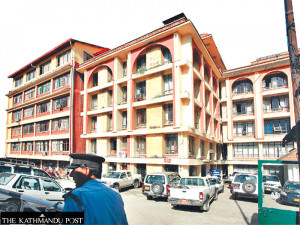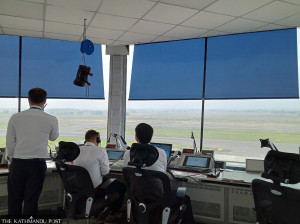Entertainment
Parallel processes
A look at Parallel Journeys
Rachana Chettri
Sunila Bajracharya
For quite some time now, Sunila Bajracharya has been known for her representations of the female form on canvas. Bajracharya’s women, their bodies, minds and consciousness, have often been dissected in parts, viewed and scrutinised from various angles and then thrown upon the canvas in striking arrays of colour. This time, however, the artist has chosen a different form to continue her study of the female figure—sculpture in mesh wire and ceramics. The most recent collection of Bajracharya’s artwork is on display at the Siddhartha Art Gallery where it is currently being exhibited as part of Parallel Journeys, with fellow artists Binod Pradhan and Asha Dangol.
Bajracharya’s work is the first you will see in the exhibit as it takes up the ground floor of the gallery. An impressive constellation of floating silver figures will catch the eye as the wall right opposite the entrance has been given over completely to their display. Bajracharya’s mesh sculptures seem to be floating in ether, their distinctly and discernibly female bodies—characterised by the almost lozenge shapes the artist has lent them here—either ‘dangling’ from the ceiling or ‘sprouting out’ of the walls. Whether or not the artist designed her pieces to fit together as an installation, the effect is certainly there. Her subject, the woman in art, carries with it millennia of having been viewed, pondered upon and represented in art, and since she has chosen to work with shapes and figures that are so close in form to the prehistoric ‘Venus figurine’ statuettes—exaggerated breasts, hips and bellies that draw the eye to the centre, and upper and lower extremities that taper off into nothingness—her artwork can be read as a commentary on the artistic representation of ‘woman’ on certain levels.
Having said this, Bajracharya’s silvery, mesh-wired women (but not quite her ceramic figurines) are also very different from the Venus figurines they seem to have been modelled after. They are not symbols of fecundity and fertility or even assertions of female sexuality. They are instead, the very heart and soul of a woman; not her body, or even her mind, but that certain indescribable thing inherited from women past. The expression here might be as simple or complex as that of the annoyance and irksomeness brought on by PMS or as hard to make sense of as confusions regarding what it really means to be a ‘woman’.
Binod Pradhan
A flight of stairs upwards and you enter an entirely different world. This is a world of fantasy—gold- and silver-tinged—and of lands far, far away. Binod Pradhan’s paintings have an almost fairy-tale appeal to them. The landscapes are sights for sore eyes and seem, at least in part, to be manifestations of the artist’s search for Shangri-la.
The entire exhibit has been titled Quest for the Temple City, and the quest continues, relentless, on canvas upon canvas now hung at the Siddhartha Art Gallery.
Pradhan’s canvases are where impossibilities are made possible; they are landscapes where utopia exists—where two things of beauty come together. The distinguishably Nepali architecture of Kathmandu’s pagoda-style temples travel to the high Himalayas in these paintings; far from the precincts of Kathmandu, in lands man cannot conquer, the temples will not rise to the chime of happy bells every morning but ring clangourous to the blowing of cold winds. Kathmandu would be bare without its old temples and the mountains would swallow these old monuments whole. In the vastness of the great Himalayas, man’s architectural triumphs would matter very little. Perhaps this is why Pradhan’s paintings have a lonely sadness permeating throughout; his landscapes are of utopias without man—alarming images for men and women who, try as they might, cannot believe that the world will exist, perhaps even flourish, without the homo sapien walking upon it.
Asha Dangol
Dystopia awaits a floor above. Asha Dangol’s canvases are surreal dreams where the artist is floating, soaring, flying above Kathmandu. If to be ‘modern’ is to be ‘radical’, his works are the most modern in the lot. Dangol has always been very upfront and in-your-face with his artwork and the Parallel Journeys pieces are no different. As always, there is the juxtaposition of traditional Newari and Mithila art, radically improvised upon with 21st century imagery. There were no war tanks, no vehicles, no gas masks before ‘modernity’, and certainly the motorcycle was yet to be invented when Da Vinci painted the Mona Lisa.
The artist’s intent is to shock and shock he effectively does. In fact one feels a certain kind of unease while looking at Dangol’s paintings. They are so unabashedly unapologetic that one is taken by surprise, for how could an artist bare himself, not just his thoughts and reflections but his face and body, for the entire world to see and critique? It would either take immense self-assurance and confidence, or unshakable belief in the ideas that are being created, replicated and sparked by his or her work. And Dangol seems to have found this kind of belief. His commentaries on urbanisation and its effects on ecology are stark as they come; the artist’s voice as loud, clear and clangourous as it can possibly get.
The exhibition will continue till February 8. Gallery hours are from 11 am to 5 pm (Monday to Friday) and 12 noon to 4 pm (Saturday)




 19.42°C Kathmandu
19.42°C Kathmandu












